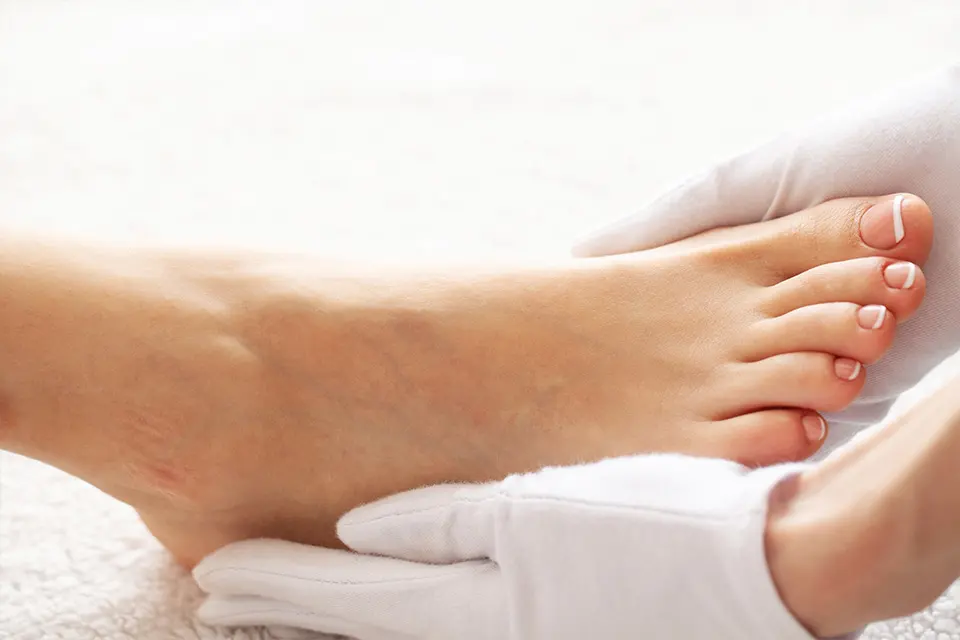Kaitlin C. Neary, M.D.
Dr. Neary’s journey to minimally invasive forefoot surgery
Learn more
As an orthopedic foot and ankle surgeon, I specialize in addressing some of the most complex and challenging issues related to the lower extremities. Every day, I work with patients who are dealing with a wide range of conditions, from debilitating bunions and arthritis to traumatic lower extremity injuries and deformities. These problems often affect not just mobility but overall quality of life, and my role is to find solutions that restore function, relieve pain, and help people get back on their feet—literally. Whether it's through traditional open surgery or minimally invasive techniques, I’m constantly problem-solving to deliver the best outcomes for my patients.
Smaller incisions. Faster healing. Lasting relief.
A new era in bunion surgery. Less pain, more mobility.
Less pain, Less swelling, Faster Recovery
Traditional open bunion corrections require long incisions and significant dissection, leading to increased pain, swelling and scarring, and prolonged recovery time compared to minimally invasive techniques. Minimally invasive bunion surgery involves minimal incisions with improved precision of the correction, resulting in significantly less pain and swelling postoperatively, reduced scarring, and faster return to normal activities.
Improved Cosmesis
Minimally invasive bunion correction offers improved cosmetic outcomes due to the use of smaller incisions, resulting in less noticeable scarring. This approach allows for more precise surgical techniques, enhancing both the function and appearance of the foot post-surgery.
Enhanced Safety and Lower infection risk
Minimally invasive bunion surgery significantly lowers the risk of infection by using smaller incisions, which reduces tissue exposure to external contaminants. With less tissue exposed, the chances of infection are notably decreased when compared to traditional open bunion surgery. This approach not only accelerates healing and recovery but also enhances patient safety by minimizing the risk of postoperative complications.
Improved Outcomes
Minimally invasive bunion surgery offers improved outcomes by allowing for more precise correction with smaller incisions, which leads to less tissue damage and a quicker recovery. Patients experience reduced pain, swelling, and scarring compared to traditional open surgery, resulting in both functional and cosmetic benefits. The enhanced precision of the procedure also contributes to a lower risk of complications, such as infection or recurrence of the bunion. Overall, this approach provides a faster return to normal activities with long-lasting, more satisfying results for patients.
Minimal scarring. Walk sooner, Pain free.
My quest for a
better approach.
Less pain, Less swelling, Faster Recovery
Traditional open bunion corrections require long incisions and significant dissection, leading to increased pain, swelling and scarring, and prolonged recovery time compared to minimally invasive techniques. Minimally invasive bunion surgery involves minimal incisions with improved precision of the correction, resulting in significantly less pain and swelling postoperatively, reduced scarring, and faster return to normal activities.
Improved Cosmesis
Minimally invasive bunion correction offers improved cosmetic outcomes due to the use of smaller incisions, resulting in less noticeable scarring. This approach allows for more precise surgical techniques, enhancing both the function and appearance of the foot post-surgery.
Enhanced Safety and Lower infection risk
Minimally invasive bunion surgery significantly lowers the risk of infection by using smaller incisions, which reduces tissue exposure to external contaminants. With less tissue exposed, the chances of infection are notably decreased when compared to traditional open bunion surgery. This approach not only accelerates healing and recovery but also enhances patient safety by minimizing the risk of postoperative complications.
Improved Outcomes
Minimally invasive bunion surgery offers improved outcomes by allowing for more precise correction with smaller incisions, which leads to less tissue damage and a quicker recovery. Patients experience reduced pain, swelling, and scarring compared to traditional open surgery, resulting in both functional and cosmetic benefits. The enhanced precision of the procedure also contributes to a lower risk of complications, such as infection or recurrence of the bunion. Overall, this approach provides a faster return to normal activities with long-lasting, more satisfying results for patients.
Smaller incisions. Faster healing. Lasting relief.
A new era in bunion surgery. Less pain, more mobility.
Bunion surgery has consistently been a central focus of my practice. In the past, performing open bunion correction was the standard approach, but over time, it became evident that this method came with numerous complications. Patients often experienced extended recovery periods, significant postoperative pain, and a higher risk of infection due to the larger incisions. Additionally, the invasiveness of the procedure often led to joint stiffness and long-term mobility issues, which impacted the ultimate outcome of the surgery. It became clear to me (even during my Orthopaedic training) that while these open bunion approaches could successfully correct the deformity, they came with too many downsides.
Minimal scarring. Walk sooner, Pain free.
My quest for
a better approach.
That realization inspired me to embark on a journey to find safer, more efficient solutions for bunion correction – ones that could achieve the same results while minimizing complications and providing a faster recovery for my patients. This drive to improve patient outcomes led me to adopt, innovate, and refine minimally invasive techniques, ensuring I could provide a higher level of care while still achieving the desired results.
I feel incredibly fortunate to have been able to develop and refine minimally invasive bunion correction, and to be at the forefront of minimally invasive foot and ankle surgery. It’s a privilege to help advance a field that has such a meaningful impact on patients’ lives, reducing their pain and speeding up recovery times. I’m grateful for the trust my patients place in me and for the opportunity to continue learning and innovating to improve outcomes. Being part of this journey, from traditional open bunion surgery to cutting-edge minimally invasive techniques, has been a rewarding experience that I never take for granted.
Your feet are in our hands!
Dr. Neary in the media
Featured Article in Orthopedics Today
MIS in Action. Real-Time Bunion Correction
Small Incisions, Big Results. MIS Osteotomy Techniques
Charcot Foot Reconstruction. See the Procedure
Schedule a consultationOur happy patients
Scar? What scar?
With Minimally Invasive Bunion Correction experience the freedom to move without pain and enjoy scar-free results. Take the first step toward a more comfortable and active life today!
Schedule an AppointmentForget about bunions, forget about pain, let's get you back on your feet again!

Other MIS Procedures
Having other bunion related issues or pain in your foot? We have you covered, check out our other MIS foot procedures.

Preparing for Surgery
Check out our resource section to help you with preparing for surgery, health insurance and telehealth. Everything you need to know.

Schedule a Consultation
Setup a personal consultation with us, get seen to and enjoy a hassle-free journey to a pain free walk, every step of the way.